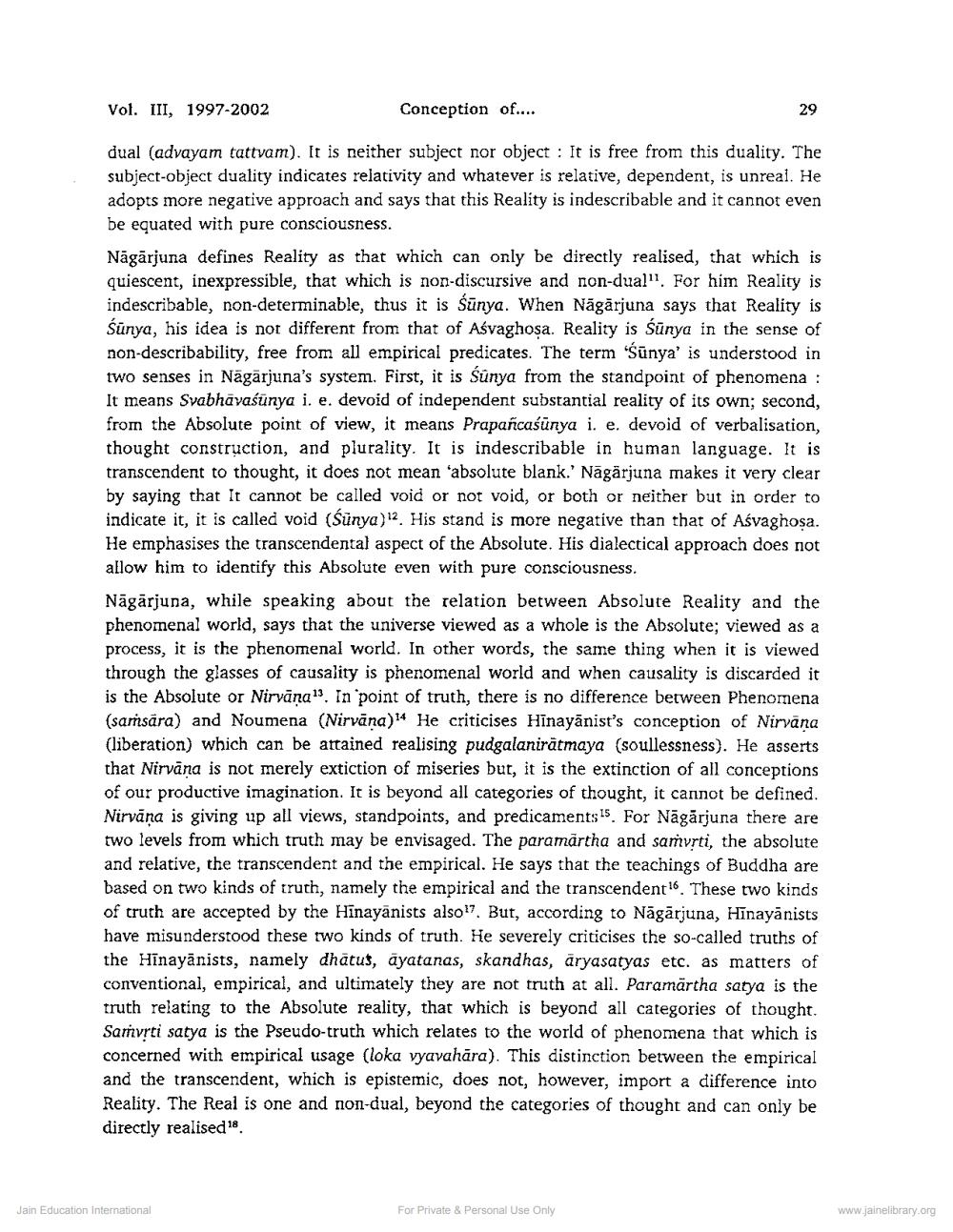Book Title: Conception of Reality in Mahayana Buddhism Author(s): Yajneshwar S Shastri Publisher: Z_Nirgrantha_1_022701.pdf and Nirgrantha_2_022702.pdf and Nirgrantha_3_022703.pdf View full book textPage 4
________________ Vol. III, 1997-2002 Conception of.... 29 dual (advayam tattvam). It is neither subject nor object : It is free from this duality. The subject object duality indicates relativity and whatever is relative, dependent, is unreal. He adopts more negative approach and says that this Reality is indescribable and it cannot even be equated with pure consciousness. Nāgārjuna defines Reality as that which can only be directly realised, that which is quiescent, inexpressible, that which is non-discursive and non-dual". For him Reality is indescribable, non-determinable, thus it is Sūnya. When Nāgārjuna says that Reality is Śünya, his idea is not different from that of Ašvaghoșa. Reality is Sūnya in the sense of non-describability, free from all empirical predicates. The term "Sūnya' is understood in IWO senses in Nāgārjuna's system. First, it is Sünya from the standpoint of phenomena : It means Svabhāvaśünya i. e. devoid of independent substantial reality of its own; second, from the Absolute point of view, it means Prapancaśünya i. e. devoid of verbalisation, thought construction, and plurality. It is indescribable in human language. It is transcendent to thought, it does not mean 'absolute blank.' Nāgärjuna makes it very clear by saying that it cannot be called void or not void, or both or neither but in order to indicate it, it is called void (Śünya) 2. His stand is more negative than that of Ašvaghosa. He emphasises the transcendental aspect of the Absolute. His dialectical approach does not allow him to identify this Absolute even with pure consciousness. Nāgārjuna, while speaking about the relation between Absolute Reality and the phenomenal world, says that the universe viewed as a whole is the Absolute; viewed as a process, it is the phenomenal world. In other words, the same thing when it is viewed through the glasses of causality is phenomenal world and when causality is discarded it is the Absolute or Nirvana"). In point of truth, there is no difference between Phenomena (saṁsāra) and Noumena (Nirvana)"4 He criticises Hinayānist's conception of Nirvana (liberation) which can be attained realising pudgalaniratmaya (soullessness). He asserts that Nirvana is not merely extiction of miseries but, it is the extinction of all conceptions of our productive imagination. It is beyond all categories of thought, it cannot be defined. Nirvana is giving up all views, standpoints, and predicaments 45. For Nāgārjuna there are two levels from which truth may be envisaged. The paramartha and samvrti, the absolute and relative, the transcendent and the empirical. He says that the teachings of Buddha are based on two kinds of truth, namely the empirical and the transcendent 16. These two kinds of truth are accepted by the Hinayānists also!7. But, according to Nāgārjuna, Hīnayānists have misunderstood these two kinds of truth. He severely criticises the so-called truths of the Hinayānists, namely dhātus, āyatanas, skandhas, aryasatyas etc. as matters of conventional, empirical, and ultimately they are not truth at all. Paramärtha satya is the truth relating to the Absolute reality, that which is beyond all categories of thought. Samvrti satya is the Pseudo-truth which relates to the world of phenomena that which is concerned with empirical usage (loka vyavahāra). This distinction between the empirical and the transcendent, which is epistemic, does not, however, import a difference into Reality. The Real is one and non-dual, beyond the categories of thought and can only be directly realised 18 Jain Education International For Private & Personal Use Only www.jainelibrary.orgPage Navigation
1 2 3 4 5 6 7 8 9 10 11
